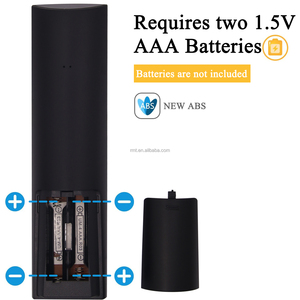(337193 products available)




























































































































































































The OEM remote control is a device that controls a product manufactured by the original equipment manufacturer. Intended for use with specific brand products, its compatibility features make it an appealing choice for customers seeking easy integration with existing systems. Broadly classified, there are two primary categories of remote controls: universal and single-device.
A universal remote control is designed to operate multiple devices, regardless of their brand or manufacturer. For instance, integrating one universal remote control into a customer's living room can ease operating the TV, sound system, and DVD player. While overcoming the brand barrier in electronics integration, universal remotes offer the flexibility of many brandless product interconnections.
On the other hand, a single-device remote control is tailored to a specific device, offering sophisticated and seamless functionality. It can be a single remote control for the TV manufactured by the original manufacturer. Often, single-device remotes provide an array of advanced features such as voice control, touchpad navigation, and personalized settings. These extras make interacting with the device an extraordinary experience, elevating it beyond the ordinary.
Nonetheless, many manufacturers opt for OEM remote control, which is a remote control manufactured by the original manufacturer of the device. They are identical to the remotes that come bundled with the device upon purchase. According to studies, about 70% of manufacturers prefer to use OEM parts when repairing electronics because they are built to the same standards and specifications as the original parts.
OEM remotes are poised to become more versatile and integrated within the smart home ecosystem as technology advances. Features like voice control through digital assistants such as Amazon's Alexa or Google's voice assistant control are likely to increase their integration capabilities. This will ensure they can be used seamlessly with smart TVs, streaming devices, and other connected gadgets.
An OEM remote control offers multiple features that enhance the user experience. It may have a compact design that makes it easy to handle and store. Some remote controls have an ergonomic design and fit the hand perfectly. This reduces hand fatigue when using the remote for a long time.
Many remote controllers have programmable buttons. They can be set to perform different functions according to the user's preference. For instance, the music adjustable buttons can be programmed to increase or lower the volume. Some remotes allow the car owner to control the programmable garage door opener.
Numeric keypads on the remote allow the driver to open the car door and input the vehicle security codes. It also enables the user to interact with multimedia systems easily. In addition to that, a multimedia keypad with play, rewind, and fast-forward functions enhances the entertainment experience.
Panic or alarm buttons on the remote control can trigger an alarm system that scares away intruders. It can signal nearby people to come to the user's aid in case of an emergency.
Many OEM remotes now come with keyless entry systems. They enable users to unlock the doors without inserting the key into the lock. Some systems even enable users to start the car engine without using the ignition key. They increase security by lowering the chances of lock break-in.
Battery indicators, compact designs, anti-slip surfaces, and custom branding are some features that increase the attractiveness of OEM remotes. They warrant the end customer's loyalty and improve their general experience while using the car.
The applications of a generic remote controller are vast. It's simple to understand why the remote has value in so many different industries, given its importance in the consumer electronics market, hospitality sector, healthcare services, and automotive and residential security industries. Its capability of seamless integration with varied systems and devices makes it an attractive choice for businesses looking to simplify operations and heighten user experiences. Here are the top industries where locally sourced remote controls are in high demand:
Sellers may consider several factors when selecting an OEM remote for their businesses. Here's an overview of things to keep in mind.
Q: What is OEM in remote control?
A: In remote controls, OEM stands for ""original equipment manufacturer."" An OEM remote is manufactured by a company that originally manufactured the device the remote is designed to operate. For example, an OEM remote control for a TV would be remote manufactured by the original TV manufacturer.
Q: Are all universal remotes easy to set up?
A: No, not all universal remotes are easy to set up. Some models may require more complicated programming steps or customization to work with multiple devices.
Q: What is the difference between a standard remote and an OEM remote?
A: The original equipment manufacturer (OEM) remote control is a replica of the manufacturer's original remote, specifically designed to match the brand and model of a certain device. On the flip side, universal remotes are adaptable and can be used with different brands and models of gadgets.
Q: Why are OEM remotes important?
A: OEMs are important because they provide parts to other companies to make their products. OEM parts are always better than aftermarket parts because they are made specifically for the manufacturer's product.